These are remnants of our sessions at the wonderful Author Conference at the Leipzig Book Fair, LBM24. As you can see, we really can’t draw. Nonetheless we tried to illustrate sophisticated approaches to storytelling such as:
– figural shadowing
– liminal storytelling
– cyclical and rhythmic storytelling
We hope our participants gained some valuable insights!
Click to develop a better story:

Guest post by Ali Luke.
 Ali Luke is a freelance writer and novelist who blogs about making the most of your writing time at Aliventures. For her best tips on making time to write, sign up for her email newsletter: you’ll receive a free copy of her mini ebook Time to Write: How to Fit More Writing Into Your Busy Life, Right Now.
Ali Luke is a freelance writer and novelist who blogs about making the most of your writing time at Aliventures. For her best tips on making time to write, sign up for her email newsletter: you’ll receive a free copy of her mini ebook Time to Write: How to Fit More Writing Into Your Busy Life, Right Now.
Pacing in fiction is how quickly—or slowly—the story progresses. The right pace for a story depends on its genre. If you’re reading a thriller, you’ll expect a fast-paced read with lots of action; if you’re reading a historical novel or epic fantasy, you might enjoy a slower pace with lots of emphasis on the world of the story.
It’s tough to get pacing spot-on when you’re drafting. It might take you years to write a book that takes just hours for someone to read. What feels “slow” to you as you write might actually go by pretty quickly on the page. Or, you may find that you repeat yourself, going over the same narrative ground multiple times, because you barely remembered what you wrote six months ago.
So, don’t worry about your pacing as you draft. Instead, address it in the redrafts—ideally, with the help of beta readers, but even simply reading over your full manuscript yourself can help you spot areas where the pace feels off.
Here’s what to look for when redrafting your work. (more…)
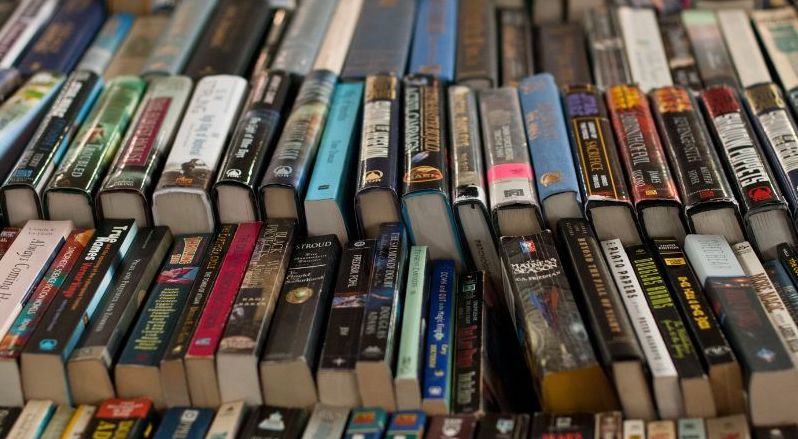
Guest post by Iris Marsh.
 In this guest post, indy writer and editor Iris Marsh describes how reading novels comparable to your own project can help you hit genre conventions and scenes the audience expects.
In this guest post, indy writer and editor Iris Marsh describes how reading novels comparable to your own project can help you hit genre conventions and scenes the audience expects.
Iris is an editor for indie authors and the author of the YA urban fantasy novel Illuminated. Iris feels everyone has a story to tell, and she loves to help other authors hone their story so they can share it with the world. To her, building the confidence of authors is key. That way, they don’t just have a better story, but they also feel more confident sharing it. Check out her website for tips and her free self-editing course.
You’ve written your story, yet you feel that there are several moments missing. The middle seems rushed or too slow. Or perhaps you’re unsure whether the climax packs the punch you were looking for.
You do know this: the story needs some editing.
But how do you know what’s missing? How can you identify what you need to improve?
Reading a few books in your genre can give you the answers you seek. By comparing them, you’ll find out what elements they have in common and how you can apply these to your own story.
Doing this is a great practice either before you start writing (to help you plot your story) or after you’ve written your first draft (to find out if your story hits the right moments).
In this article, we’ll discuss which books you should pick to read, what you should pay attention to when reading, how to compare what you’ve read, and how you can use this information to improve your story. (more…)
So wrote the great film director Sidney Lumet.
As we have seen, there are two parts of the process to creating a story. One is concerned with the story itself, with what the story comprises and the arrangement of its elements. The other has to do with how you tell it, with the text of the manuscript or screenplay.
Or let’s try another approach to understanding how interwoven the two aspects structure and words are. In Chinese, the word for literature and writing is “wen”, and this word originally meant “pattern”, or design, as for example of woven silk. A pattern is structure.

Consider a tree in winter. Its trunk and branches are the ‘bare bones’ of the organism. Only in spring and summer, when leaves and flowers come out, does it really come alive, does it truly reach its full potential in our eyes, does it become a complete tree in its ideal state. Without the trunk and branches there would be nowhere for the leaves and flowers to grow. So perhaps as an analogy we can see the trunk and branches as the story, and the leaves are the words. And the flowers? Well, maybe they are metaphors …
As Lu Chi put it in third century C.E.,
“When the substance of a composition, trunk of a tree, is by Truth sustained,
Style aids it to branch into leafy boughs and bear fruit.”
Translation Shih-Hsiang Chen, in Cyril Birch’s Anthology of Chinese Literature (more…)

A story has a beginning, a middle, and an end. How to avoid the ‘saggy middle’.
The middle bit of a story is really the story proper. It is usually the longest section. It comes after the introduction of the main character(s) and the setting up of the context, that is the world of the story, as well as the problems and themes the story deals with.
At the end of the first section – prior to what we’re here calling ‘the middle bit’ –, the protagonist has decided to set off on the story journey. Obviously, this does not have to be physical journey through a particular geography, but it does mean that the main character is somehow entering into new and unfamiliar terrain. In this sense, every story is a ‘fish out of water’ story. The heroine must leave the comfort zone in order for the audience to feel interest in her plight.
Some authors jump right into this unfamiliar territory, showing the run up to it in flashbacks. Anita Brookner’s heroine Edith Hope has already arrived in the Hotel du Lac in the first sentence of the novel. Gradually the reasons for her stay here are revealed as the reader progresses through the novel.
Nonetheless, for an author, it may be advisable to create a marked threshold where the protagonist enters into the alien territory of the middle bit. The exploration and transversal of this territory is what on a plot level the middle bit is about, and it takes up the greater part of the story journey. (more…)

Creation Takes Time.
This is an age of faster, faster, more, more. At the latest since the advent of the internet, everything seems to be speeding up. Processes that took weeks a few decades ago now take only a few hours, things that in the twentieth century took hours now take place within minutes or seconds. You can get from A to B in less time than ever. The requirements on most of us for most of our work call for ever greater efficiency. We must not waste time. We must be quick.
Composing a story is a painstaking process. And yes, here at Beemgee we built our fiction tool in order to make the process of composing a story more efficient. We want to make it easier to organise a plot and determine the characters’ motivations – for the authors themselves, and for all the people communicating about the story, so between interested parties such as authors and their editors or screenwriters and producers.
But though we might want our authors’ efficiency to increase, let’s not kid ourselves. Composing a story is still a painstaking process. Because most of the time is spent thinking.
Thinking takes time. And that is mostly what plotting and outlining a story really is, thinking. (more…)
What a character might know that others don’t – including the audience

Some characters have secrets. We are not necessarily talking about their internal problem or the need that arises out of it (they may be aware of such a problem or not.) We are talking about information that makes a difference to the story once it is shared.
Character secrets are intimately bound to the scene type called a reveal (which does not necessarily have to entail a revelation).
In terms of story (or rather the dramaturgy of the story), if a character has a secret that is never revealed, the secret is irrelevant. Only if the secret is made known at some point in the narrative does it really exist as a component of the plot.
For authors, the main aspects of character secrets to control are:
- What plot event brings the secret about (this may be a backstory event)?
- How does the secret alter or determine the character’s decisions or behaviour?
- Does the character share the secret with another character at any point, and if so when (in which scene)?
- At what point in the narrative (in which scene) does the audience receive knowledge of this secret?
Who are you, really?
If it is so important the character has a secret, then, often, the secret becomes part of who this character is. Their role in the story, their identity within the story, is determined by their secret. So secrets are dramaturgically important. (more…)

The midpoint is structurally the most significant point in a narrative.
Given that stories have a tendency to symmetry, the centre of a narrative should mark the zenith of the story arc, and with that, the pivotal point of the story.
So, to get to (mid)point: What happens in the middle of a story?
Here are some typical midpoint events:
- Something searched for is found (Star Wars IV, Raiders of the Lost Ark, Lolita)
- A hidden truth is unveiled (to the audience, at least) – if not yet understood (Matrix, Pride and Prejudice, The Gruffalo)
- A dramatic event thwarts all plans made hitherto (James Cameron’s Titanic)
The centre of the narrative may be the discovery of something missing – in crime stories a vital piece of the puzzle may be revealed here (either to the audience or to the audience as well as the protagonist).
In any genre or dramatic category, the midpoint may be a moment of truth. This might be just a clue for the audience or perhaps an initial revelation of the true state of things.
If a character realises or finds out something that has so far been hidden, then this is the point at which the character begins to gain awareness. This counts in particular for the recognition of the character’s own internal problem. From here on the story might possibly lead up to a moment of choice at the crisis, when it becomes clear to the audience whether the character has learnt from this new awareness or not. In other words, the real need begins to overcome or supplant the character’s initial want due to what happens at the midpoint.
Some well-known examples of the midpoint
(more…)
 Today’s guest post is by author Stefan Emunds.
Today’s guest post is by author Stefan Emunds.
Stefan’s favorite genre is visionary fiction – stories that have an enlightenment dimension. Enlightenment and storytelling have interesting parallels, which prompted Stefan to write a book about storytelling – The Eight Crafts of Writing.
Get a glimpse of his approach to story craft in his article.
Art and Craft
Storytelling is both art and craft, authoring and writing, plotting and pantsing.
1.1 Art and Authoring
Art is creativity. Creativity requires receptivity to the Muse and its inspirations.
Inspirations arrive as thought-images, which writers put into words. How to turn thought-images into words and assemble those into a structured story with vivid characters and an engrossing world is a matter of craft and skill.
1.2 Craft and Writing
The literal meaning of Kung Fu is a discipline achieved through hard work and persistent practice. Writing is Kung Fu.
Craft gives form to inspirations. Forms limit. Writers love the artistic side of writing, less so crafting, in particular, Story Outline. Writers are prone to procrastinate crafting.
But no limitations, no story. No canvas, no painting. No net, no tennis.
Understanding the difference between freedom and dominion helps to appreciate the constraints of craft. Freedom is a means to an end. We want to be free to do something, for example, to write a book. That’s all there is to freedom. Dominion, on the other hand, is mastery of structure. (more…)

Nothing should be more important to an author than how their story makes the audience feel.
As an author, consider carefully the emotional journey of the reader or viewer as they progress through your narrative.
The audience experiences a sequence of emotions when engaged in a narrative. So narrative structure is a vital aspect of storytelling. The story should be touching the audience emotionally during every scene. Furthermore, each new scene should evoke a new feeling in order to remain fresh and surprising.
The author’s job is to make the audience feel empathy with the characters quickly, so that an emotional response to the characters’ situation is possible. Only this can lead to physical reactions like accelerated heartbeat when the story gets exciting. We have to care.
This “capturing” of the audience, making the reader or viewer rapt and enthralled, requires authors to create events that will show who the characters are and how they react to the problems they must face. The audience is more likely to feel with the characters as the plot unfolds when the characters’ reactions to events reveal something about who they really are – and how they might be similar to us.
One Journey to Spellbind Them All
Here we present a loose pattern that we think probably fits for any type of story, whatever genre or medium, however “literary” or “commercial”. It’s not prescriptive, just a rough checklist of the stages in the emotional journey the audience tacitly expects when they let themselves in on a story. The emotions are in more or less the order they might be evoked by any narrative.
Curiosity
(more…)

Guest Post by KT Mehra.
KT Mehra knows a thing or two about writing from her own experience, not only as an author but as a supplier to writers and authors of fine stationary, in particular fountain pens. Not only that, she is digital savvy too.
Back in 1999, KT and her husband Sal started a small web company to create websites for local businesses and provide internet access. They both had a passion for fountain pens, and one day KT, in an excess of enthusiasm, ordered far too many from a pen company. Just for fun, she decided not to return any of them and instead asked her team to design an e-commerce website to sell the extra pens.
To everyone’s surprise and just like that, the website came together quickly and was an instant success.
KT believes that in the modern digitally saturated world, it’s more important than ever to stay true to your thoughts and create something tangible. In that spirit of creation, she feels that something as elemental as putting pen to paper is ever more essential.
Despite offering a digital tool for authors, we couldn’t agree more!

Develop a romantic relationship that your readers will engage with and root for.
Most of the romance novels you love so much use certain secrets to hook their readers in and keep them engaged.
Learning the secrets to create such compelling romance novels will help you perfect your characters’ love story.
The Basics
The best way for your readers to relate and root for your relationship is for you to make it realistic and dynamic. To build the foundation of any great love story, you need to have a few things down first. (more…)
Outlining a story means developing the characters and structuring the plot.
Beemgee will help you outline your plot using the principle of noting ideas for scenes or plot events on index cards and arranging them in a timeline. This is a separate process from actually writing the story. Most accomplished authors outline their stories before writing them, because it saves rewrites later.
Find a video here.
In this post we will explain –
The Beemge author tool is divided into three separate areas, PLOT, CHARACTER and STEP OUTLINE. You navigate them easily in the top menu.

Important note: Make sure to stay in the same browser window in whichever area you’re working. Having one project open in multiple windows may result in some of your input being lost.
How To Create An Event Card
(more…)
In the summer of 2015 in a run-down part of Berlin, three guys made their way to a notary.
They were in the process of founding the company Beemgee GmbH. There was no product yet, but they did share a conviction and a vision: to help writers and storytellers everywhere conceive, develop and outline their stories.
Today we are proud to celebrate five years of Beemgee with a whole host of new features. Premium users can now access a dozen new attributes in the PLOT and PITCH sections of the Beemgee story development tool.
> > NEW PLOT FEATURES
How ever you work, whichever is your favoured process, you can do it in Beemgee.
The additional plot attributes live now are:
- Dramaturgy
- Hero’s Journey (new)
- Hero’s Journey (classic)
- Plot Beats
- Story Anatomy
- Audience’ Journey
(more…)
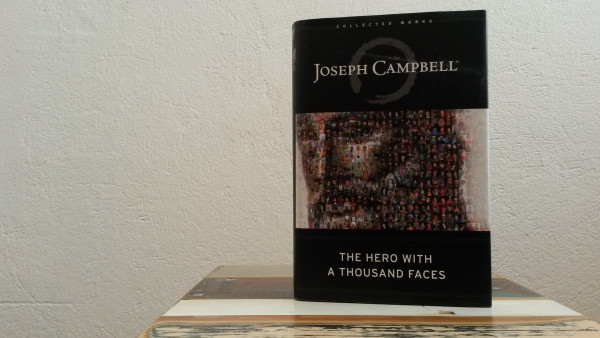
Joseph Campbell: The Hero With A Thousand Faces.
Joseph Campbell’s study of worldwide myths, The Hero With A Thousand Faces (1949), has become massively influential in commercial storytelling. Campbell was not the first to consider the concept of the hero and mythological or archetypal stories, and by no means the last (see Northrop Frye, as well as Robert Scholes and Robert Kellogg). But Campbell’s work consolidated what others, including Carl Jung, had suggested into a theory specifically about storytelling.
George Lucas read The Hero With A Thousand Faces as a young man, and we may assume that Francis Ford Coppola and Steven Spielberg were also familiar with the book. We can see the influence of Campbell’s ideas on some of the most successful movies of the 1970s and 80s, and ever since.
Christopher Vogler studied film at the same school as George Lucas, and subsequently while working at Disney wrote a seven-page breakdown of Campbell’s book. This in time developed into The Writer’s Journey, which has become the basis of the popular conception of The Hero’s Journey.
Campbell was an expert on James Joyce and a professor of literature with a particular interest in comparative mythology and comparative religion. The Hero With A Thousand Faces is by no means a how-to book or a storytelling manual. Rather, it posits the theory that all the myths of the world have elements in common and propounds the idea of the “monomyth” as a basic structural model of traditional storytelling. (more…)
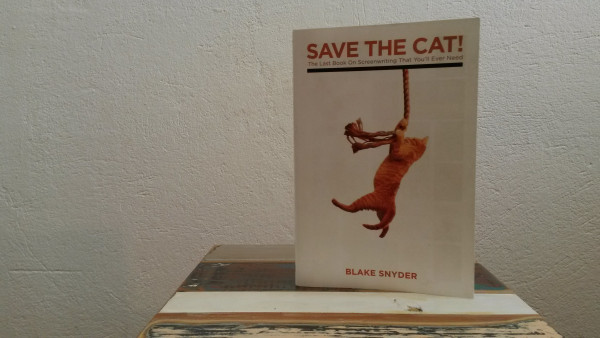
There are two definitions of story beat. Both of them refer to a change.
One use of the term beat refers to the subtle change in the dynamic of a relationship that a line of dialogue brings about in a scene. There are usually several beats within a scene, each a marker for pushing the scene forwards dramatically.
The other meaning of the word beat in storytelling applies to changes in the plot brought about by scenes. A plot is a succession of events linked causally, a narrative chain of cause and effect. One event effects a change, determining what happens in subsequent scenes. Writers might arrange these events on a board or “beat sheet” during the planning phase. (more…)
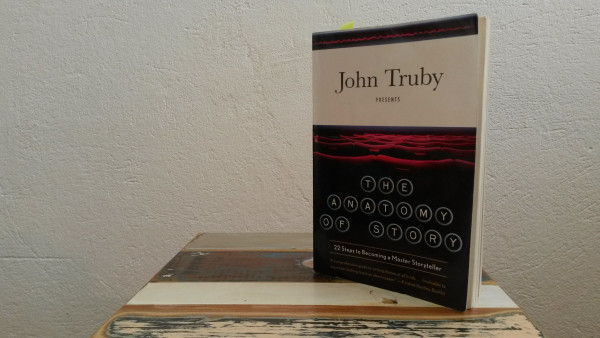
The essential elements of a story.
One of the many experts on storytelling to have attempted in a book to describe the essential elements of a story is John Truby.
In The Anatomy of Story (2007), Truby identifies 22 steps in any protagonist’s narrative, which may play into four aspects of the story: character, plot, story world, and moral argument. Thankfully, Truby does not insist that every story must follow the template strictly and contain all 22 steps. He does, however, identify as critical that the story show seven attributes of a main character and their storyline: (more…)

Dramaturgy means “the craft or the techniques of dramatic composition”.
In other words, everything to do with the story except the words with which it is told. If your story is about two people in a room, dramaturgy tells you who these people are and what happens in the room. In terms of storytelling process, the term dramaturgy refers to the planning or outlining stage rather than the execution or writing.
The study of dramaturgy has produced a nomenclature that is used by dramaturges, script consultants, story advisors, editors and publishers, producers and filmmakers, as well as authors. Some terms may seem more familiar than others, and often their definitions are not entirely agreed upon. (more…)
Highlight and Filter Your Scene Details.
(more…)
Set the structure markers in the NARRATIVE order, see them in both sort orders.
(more…)

By Lucia Tang.
Lucia is a writer with Reedsy, a marketplace that connects authors with editors, designers, and marketers. In Lucia’s spare time, she enjoys drinking coffee and planning her historical fantasy novel.
Whether we’re piecing together the timeline for a homicide or puzzling out the intricacies of Newtonian mechanics, cause and effect are crucial to how we make sense of, well, everything. Of course, I say “we” loosely. As writers, most of us won’t actually be catching killers or solving the coefficient of fiction. But still, stories are no exception to this rule: without cause and effect, they fall apart.
At the end of the day, writers should have as tight a grasp on causality as any detective or physicist. It doesn’t matter if you’re working on a doorstopper to rival War and Peace, or a breezy picture book for baby bookworms: you’ll need to craft a storyline that makes sense. This makes your readers want to spend time in the world you’ve created — and ensures they’ll leave it feeling enlightened and satisfied.
Of course, you can get there haphazardly, writing juicy scenes as they come to mind and attacking the chaos of your draft with a merciless red pen. But if you want to save time during the editing process, keep cause and effect in mind as you plot. (more…)
How does a publisher decide which manuscript to publish?
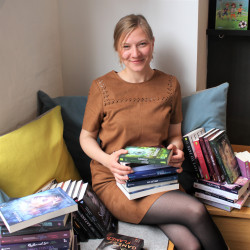 Nicole Boske heads the editorial team at Impress and Dark Diamonds, imprints of Carlsen Verlag.
Nicole Boske heads the editorial team at Impress and Dark Diamonds, imprints of Carlsen Verlag.
Even as a child I tried to discover the magic behind the printed word, and I knew my dream job before I started studying German. I always wanted only one thing: to help great novels find a home – in the hearts of their readers.
In the summer of 2014, my wish became reality. Under the shining grey sky of Hamburg I started as an editor for Impress and Dark Diamonds, both imprints of the famous publishers Carlsen Verlag [German publisher of the Harry Potter books]. As programme manager, a position I assumed in December 2018, my responsibilities also include planning and finalizing the programme and ultimately deciding which novels will be published. A pleasure as well as a challenge. We can’t publish all the manuscripts submitted to us, even if there’s an enormous amount of passion behind every single one of them.
But how exactly do we make a programme?
(more…)
How narrative structure turns a story into an emotional experience.
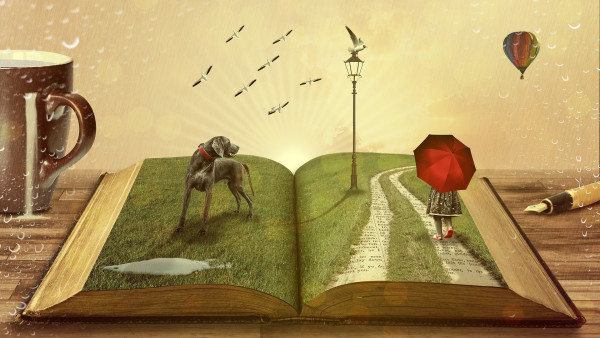
Image: Comfreak, Pixabay
Storytelling is a bit of an overused buzzword. While we are all – by dint of being human – storytellers, how aware are you of the principles of dramaturgy? What exactly constitutes a story, in comparison to, say, a report or an anecdote?
And just to be clear, the following is not a story. It’s an how-to article.
Whatever the medium – film or text, online or offline –, storytelling has something to do with emotionally engaging an audience, that much seems clear. So is a picture of a cute puppy a story? Hardly.
Stories exist in order to create a difference in their audience. Stories always address problems and tend to convey the benefits of co-operative behaviour.
While there simply is no blueprint to how stories work, let’s examine the elements that recur in stories and try to find some patterns.
Who is the story about?
All stories are about someone. That someone does not have to be a person, it can be an animal (Bambi) or a robot (Wall-e). But a story needs a character. In fact, all stories have more than one character, with virtually no exceptions. This is because the interaction between several characters provides motivation, conflict and action.
Moreover, stories usually have a main character, the figure that the story seems to be principally about – the protagonist. It is not always obvious why one character is the protagonist rather than another. Is she simply the most heroic? Is she the one that develops most? Or does she just have the most scenes?(more…)
Antje Tresp-Welte is the winner of the Your Perfect Plot challenge set by BoD and Beemgee.
In her guest blog post, she gives frank insight into her writing process and her experiences with Beemgee.
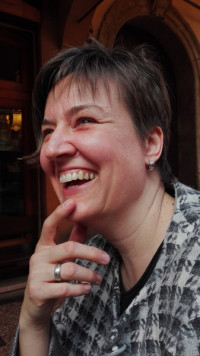 Short stories were child’s play
Short stories were child’s play
When something intrigues me, I spin a story out of it. Until a few years ago I wrote mostly fairy tales, short stories for adults, poetry and stories for younger children, some of which were published in magazines. My story about a bad-tempered spectacled snake was published as a little book, “Charlotte and the Blue Lurker”. For all these stories I only sketched a few thoughts as planning and then wrote them down relatively quickly.
By now, book projects fascinate me too. Currently they are crime novels and fantasy for children from 8 or 10 years.
Long takes longer …
During a holiday at the North Sea I had the idea for my first crime novel. In it, the protagonist, an eleven-year-old very imaginative boy with a penchant for drawing, not only saves his grandma’s tea room from demolition, but is also involved in a mysterious story about a pirate who died long ago. I developed the original idea into a plot at a seminar for authors. I found the topic so great that I couldn’t wait to start writing it. Beforehand, I made notes on the individual characters and considered important cornerstones of the plot with the help of the hero’s journey. I started off with a great momentum and was soon able to read the first chapters to my son. Unfortunately his comment was, “Mama, that is much too long!”
… not to be longwinded
My two test readers came to a similar conclusion and I too had noticed that it somehow “grated”. I wasn’t really getting to the point. Was it due to my preliminary planning? Was it not detailed enough? I dived into the text, shortened passages, removed individual characters and worked out others more precisely. This changed entire storylines. At the same time my story gained more (narrative) speed and I found the tone for the language. (more…)
What do we mean when we talk about story structure?
A story is a complex entity comprising many interrelating parts. The author imposes some sort of organising principle onto the material, turning the story into a narrative. The result of this forming or shaping of the material is the story structure.
Certain structural markers are so explicit that the audience is aware of them, such as chapters in novels. Elizabethan plays are typically divided into five acts. A film script is broken down into acts, sequences, and scenes.
The beat is the smallest unit of story, below the scene in the structural hierarchy. It is the space between an action and the reaction it causes within a scene.
- Beat
- Scene
- Sequence
- Act
- Story
A plot event is not part of this traditional hierarchy, being more of a meta-unit somewhere between beat and scene.
Scenes and acts are defined in screenplays, like chapters in novels. But stories have structures that are not usually made obvious or explicit.
Beats
There are two different understandings of the term beat.
A scene may be broken down into beats – marked only by the moments when the mood or relationship the scene describes changes. Two characters are having a conversation, character A says something which makes character B react in a different way from what A expected – that’s a beat.
The term beat is also sometimes used when marking such changes on a bigger scale, across an entire narrative. Some screenwriters work with so-called beat sheets; in the Beemgee outlining tool, the plot event cards are perfect for creating beat sheets, since each card is designed to stand for one plot event. In a beat sheet, a beat is one unit of plot. If you think of narrative as a chain of events, then each beat is a single link. In one school of thought, a Hollywood movie is ideally constructed of exactly 40 such beats. (more…)
The process of writing is unique to each author.
There is no right or wrong way to write a work of fiction. Perhaps the main thing is to just sit down and get on with it.
Many authors start by writing the beginning of the story and working their way through to the end. This seems intuitive, as it mirrors the way narratives are normally received – from opening to resolution. Furthermore, it allows a development of the material that feels natural, beginning probably with a setting and a character or two and growing in complexity as the story progresses.
But this isn’t the only way to get a story written. The author is not the recipient, after all. The author is the creator.
Creative habits seem to differ according to medium. Most screenwriters spend a lot of time working out the intricacies of plot and complexities of character before beginning to actually write the screenplay. Some novelists, on the other hand, seem to require the writing process in order to get to grips with the material. For such authors, the act of working on text is so intimately intertwined with the craft of dramaturgy that the shaping of the story has to be performed simultaneously with the writing of it.
Flow
In some cases, a writer might have a fairly clear idea in mind where the story is headed, or already be aware of certain key scenes that ought to be included. In others, the author may not know how the story ends(more…)

Conflict is the Lifeblood of Story.
In real life, conflict is something we generally want to avoid. Stories, on the other hand, require conflict. This discrepancy is an indicator of the underlying purpose of stories as a kind of training ground, a place where we learn to deal with conflict without having to suffer real-life consequences.
In this post we will look at:
- An Analogy
- Archetypal conflict in stories
- Conflict between characters
- Conflict within a character
- The central conflict
Along with language (in some form or other, be it as text or as the language of a medium, such as film) and meaning (intended by the author or understood by the recipient), characters and plot form the constituent parts of story. It is impossible to create a story that does not include these four components – even if the characters are one-dimensional and the plot has no structure. However, it is formally possible to compose a story with no conflict.
It just won’t be very interesting.
In terms of narrative, conflict is presented as a series of confrontations of increasing intensity. If there are no confrontations – no battles of wits or fists, no crossing of swords or sparring with words – there is little to hold the audience’ attention. To create confrontations, there must be at least a of conflict of interest between the characters.
Conflict does not occur at particular points in a story. It permeates the whole of it. It expresses the values transported by the story’s theme. It creates at least two options of choice, both of which must appear to some extent reasonable and justifiable to the protagonist, particularly at the moment of crisis.
(more…)
In essence, there are three kinds of opposition a character in a work of fiction may have to deal with:
- Character vs. character
- Character vs. nature
- Character vs. society
However, this way of categorising types of opposition is not equivalent to internal, external and antagonistic obstacles. Any of the three kinds of opposition listed above may be internal, external, or antagonistic. It depends on the story structure.
External opposition
In any story, the cast of characters will likely be diverse in such a way as to highlight the differences and conflicts of interests between the individuals. In some cases, certain roles may be expected or necessary parts of the surroundings, i.e. of the story world. In the story of a prisoner, it is implicit that there will be jailors or wardens, whose interest it will be to keep the prisoner in prison, which is in opposition or conflict with the prisoner’s desire for freedom.(more…)
Certain universals are feared by almost everyone. Such as death.
If a character in a story has loved ones, losing them is an even stronger fear.
A story engages the audience or readers more strongly when there is something valuable at stake for the character, such as his or her own life or that of a loved one. So giving a character a universal fear is usually a good place to start.
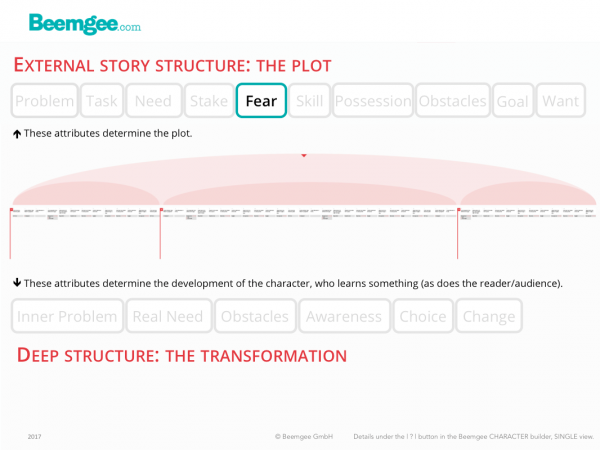
Giving a character a specific fear to overcome requires this information to be placed early in the narrative. The fear is then faced at a crisis point in the story, usually the midpoint or the climax.
Characters can have specific fears. A fear which is specific to one character must be set(more…)
You’re on a boat, and you see somebody fall into the water. Which of the following two cases would cause you to react with stronger emotion?
- The water is four feet deep and you know that the guy who fell in is a good swimmer
- The water is four feet deep and the person who fell in is a three year old girl who can’t swim
Presumably your emotional reaction would be stronger if the child fell off the boat. Because you know that the child’s life is at stake. The first situation is not life-threatening, the only thing at stake is the dryness of the man’s clothes and his self-esteem.
The degree you care about events that happen to people, and to yourself, is directly related to what’s at stake. This applies as much to fictional characters as in the real world.
Hence it is immensely important for storytellers to(more…)
In a story, if the treasure is what the hero wants, then slaying the dragon is the goal.
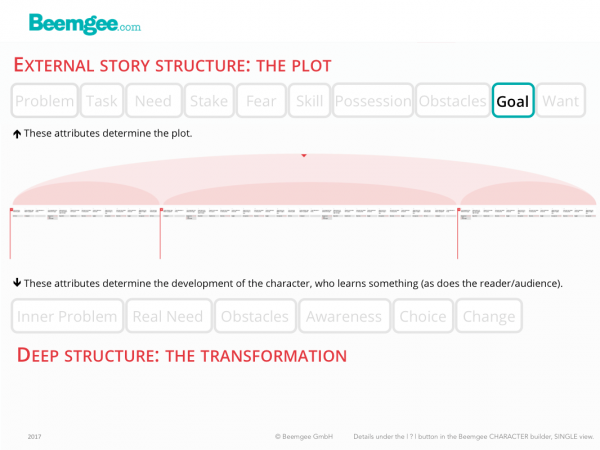
The goal is what the character thinks will lead to the (satisfaction of the) want.
Since the treasure hoard has been there for ages, there must usually be some sort of trigger for the story to get started, i.e. for the character to want the hoard now, at the time the story begins. Often, an external problem creates such a trigger. It might supply a reason why the hero needs the hoard now, something more specific than just the general sense of wanting to be rich. Perhaps the hoard isn’t the reason at all. Perhaps there is a princess in distress, which certainly adds urgency to the matter. Either way, dealing with the dragon is the goal.
If somebody says the word “goal” to you, the image that springs to mind might have to do with the ends of a football pitch. The(more…)
Stories are about people who want something.
We can distinguish between two different types of want:
- the wish, or character want
- the plot want
Marty McFly wishes to be a musician (character want). He also wants to get Back to the Future (plot want).
The wish or character want is a device which adds cohesion to the story, usually in the form of the set-up/pay-off. Marty is seen at the beginning of the film practicing the guitar; at the end of the film he plays at a concert. A character-inherent wish is a useful technique to make the character clearer to the audience, but it is not essential to composing a story.
Indispensable is what we have called the plot want. As a result of the external problem – the trigger event that sparks the chain of cause and effect which the bulk of the plot consists of –, the character feels an urge, which provides the motivation for the character’s actions in the story.
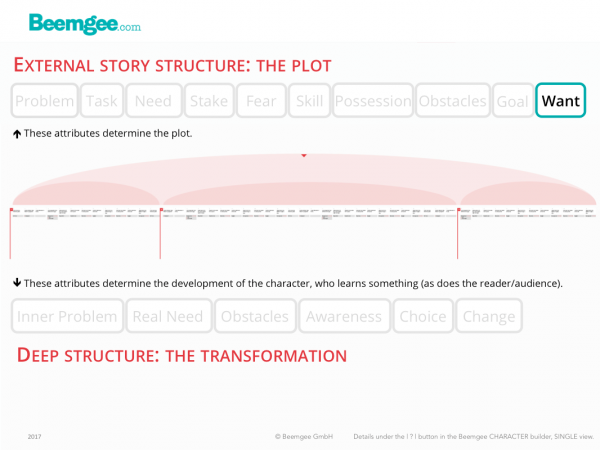
The want is the state for which the character strives, and is distinct from the goal.
In this post we’ll be talking about active vs. passive characters, motivation, the difference between a want and a goal, a couple of writer traps to avoid, and contradictory wants.
Active Characters
Characters have to be actively acting of their own volition. The want has to be urgent and strong enough for them to do things. If the want is missing or too weak, the character will lack motivation and appear passive. A passive character is usually not interesting enough to hold the audience’ or readers’ attention.
Why is this so?
Evolutionary explanations of stories attempt to shed light on the phenomenon. When characters react to events rather than cause them, they appear weak, as victims in a chaotic, uncontrolled world. Which means that there is not much we can learn from them. Humans try to see cause and effect in everything, not just in stories. And humans experience stories physically and emotionally (our hearts beat faster, our palms sweat), so there is really not much difference between how we experience a story and real life. Since we learn from experience, we instinctively prefer stories which provide us with experiences that benefit us in some way. In stories we vicariously experience or practice primarily social problem-solving, without suffering real-life consequences. We tend to learn more when we experience stories of self-motivated problem-solving.
Motivation
There is a good reason for that cliché about actors always asking about their motivation. It is motivation that prompts the characters in a story to do the things they do. Stories seem to work best not only when characters are active rather than passive, but often when they have comprehensible reasons for their activity.
The reason for what a character wants is usually comprehensible for the audience or reader because of the external problem. In simple terms, the character wants to solve the problem. Take the Cinderella story as an example. Her problem is that she is bound to the stepmother and her two nasty daughters.
In other words, the want is a vision the character has of his or her situation without the problem. Hence what the character wants is actually a particular state of being. Such a state might mean being in a position of wealth, power or respect, or being in a happily ever after relationship. Cinderella wants merely to be free of her involuntary servitude, if only for a little while.
This makes the want distinct from the goal, which is the specific gateway to the wanted state of being, as perceived by the character. A story usually sets up a goal the character needs to reach or attain in order to achieve the want. In Cinderella’s case, it is attending the ball.
So, a story has its characters pursue their wants. These different wants oppose each other, causing conflicts of interest. The conflicting wants make the characters active, and the audience/readers like stories about actions, that is, about characters who do things.
Sounds simple.
And yet frequently stories seem to mess up on this vital point.
Next to passive characters without a strong enough want, lack of clear motivation is a huge writer trap. It is possible to write a whole story full of characters who are reactive instead of active, or who do things of their own volition but without that volition being clearly recognisable to the audience/reader. It is perhaps even tempting to write stories like that, because they seem more lifelike. In real life, people do not necessarily have distinct goals. Often, our wants are vague and not clearly definable. What about writing a realistic story about a character with a general sense of dissatisfaction, who, like so many of us, has lost sight of any clear objective in life?
It’s doable, certainly. But the audience/readers will probably start to look for the specific want of such a character. They would probably begin to expect the story to be about this character’s search for a clear objective in life. That might be the want the audience would tacitly ascribe to the character.
And if the story does not bear such motivation out, the risk is significant. Because stories in which the audience does not understand what the characters want lack emotional impact.
Contradictory Wants
A way of adding psychological depth and emotional complexity to characters is to give them several and even contradictory wants. Gollum in Lord Of The Rings wants the ring. Yet a part of him also wants to give up the ring and help Frodo. Next to solving the case, Marty Hart in True Detective wants to be a good husband and family man, but he also wants affairs with other women. That’s three wants for one character.
A want is not merely a yearning, it is an expression of values. What a character desires shows the audience something about that character. In this sense, two contradictory wants provide the basis for a powerful scene of choice. At a crisis point, the character may face a dilemma and have to choose between two courses. Both might lead to some state the character desires, but these desires prove to be mutually exclusive. For the audience, which choice is the right one might be obvious – they will be rooting for the character to go one way. But for the character there may be a strong pull the other way. The final choice shows the character’s moral fibre – and often expresses the story’s theme.
When not to want
Is it really always absolutely necessary for every character to have a clearly defined want?
Not entirely. Because, of course, there are exceptions.
In certain cases, the author might deliberately obfuscate the why of a character’s actions in order to inject mystery. Not knowing something keeps the audience/reader guessing and turning the pages or not switching the channel. Usually this mystery is cleared up at some point. The audience tends to expect that. Which implies that even if the want was not made clear to the audience early in the story, it was there in the character nonetheless – and certainly the author was aware of it.
Injecting mystery by keeping character motivations hidden is not in itself a writer trap. But nearly. When tempted to use such a device, an author should at least consider if it would not actually be more interesting for the audience to know the character’s motivation.
Having said that, there are rare cases where a character’s motivation does remain unexplained. And those cases can be powerful. Especially when it’s a baddy we don’t understand.
Think of Iago in Shakespeare’s Othello, who is simply bad to the bone and we’ll never really know why. Shakespeare – deliberately, one presumes – gives no hint as to what Iago hopes to achieve by ruining Othello. Shakespeare might easily have given Iago some clearly understandable motivation, such as revenge of a past wrong, envy of Othello’s success, desire to usurp Othello’s position, lust for Desdemona. But he didn’t. And Iago is one of the most superb villains ever.
Another possible exception are (fiction) memoirs in the first person, such as David Copperfield, The Catcher in the Rye, Saul Bellow’s The Adventures of Augie March, or William Boyd’s Any Human Heart. In such stories, the effect of the narrator telling his or her own story creates a disparity between the time of the story told and the implicit future time of the act of telling. The narrator is relating a past from the perspective of an older self. This older self has reached a state of being which is different from that of the character being told about – the narrator is wiser than his or her younger self. This creates an effect for the reader: the reader wants to know how the character reach this older, wiser state. With this device, it is possible to make character wants less obvious or direct and still maintain an emotional drive to the story.
Perhaps the most interesting thing about a character’s want is how it stands in conflict with what that character really needs.
Related function in the Beemgee story development tool:
Character Developer
Click to open a new story project:
Action is character.
So the old storytelling adage. What does that mean, exactly?
In this post, we’ll consider:
- The central or pivotal action – the midpoint
- Actions – what the character does
- Reluctance
- Need
- Character and Archetype
The central or pivotal action – the midpoint
More or less explicitly, the main character of a story is likely to have some sort of task to complete. The task is generally the verb to the noun of the goal – rescue the princess, steal the diamond. The character thinks that by achieving the goal, he or she will get what they want, which is typically a state free of a problem the character is posed at the beginning of the story.
The action is what, specifically, the character does in order to achieve the goal (rescue the princess, steal the diamond). In many cases, this action takes place in a central scene. Central not only in importance, but central in the sense of being in the middle.
Let’s look at some examples. (more…)
In most stories, the protagonist has something to do.
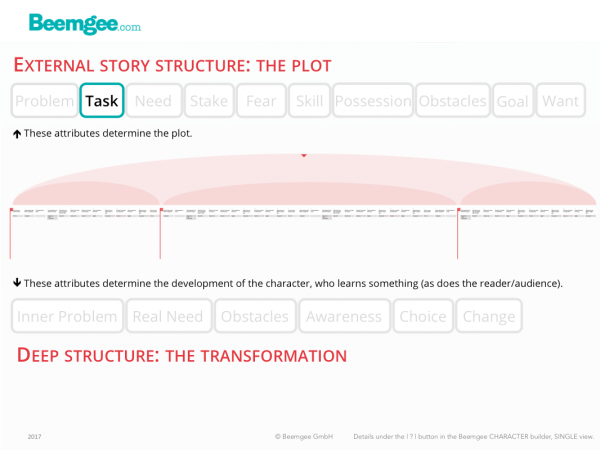
The task is the more or less explicitly defined mission a character sets out on in order to reach the goal and thereby solve the external problem.
Many of the major characters in a story will have something to do, which may result in them getting in each other’s way.
Task as Function
In a story, more or less everyone has a task. What characters do in a story defines them and determines their roles and narrative functions in the story. In this sense, it is an antagonist’s task to get in the way of the protagonist; an ally’s task is to help the protagonist; a mentor’s task is to advise the protagonist and set them on their way.
But while all that is true, it isn’t really what we mean by task.
Task as Action
The characters’ actions make them who they are. To define a character’s task is to state clearly what that character has to achieve in the story. It is the action that leads to(more…)
A character with a goal needs to do something in order to reach it.
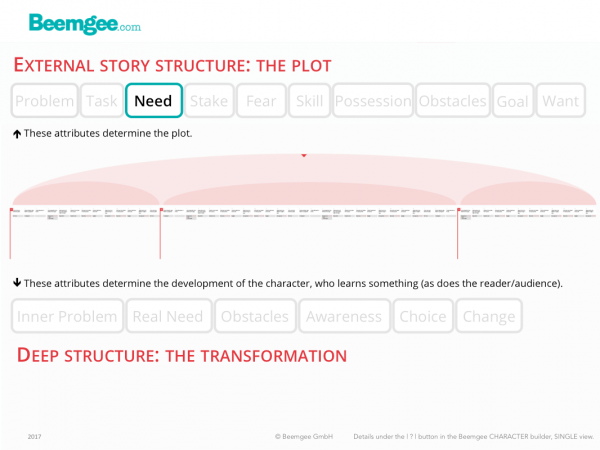
The outward needs of a character – things she needs to acquire or achieve in order to reach the goal – divide the story journey into stages.
In storytelling, characters usually know they have a problem and there is usually something they want. They tend to set themselves a goal which they believe will solve their problem and get them what they want.
In order to get to the goal, the character will need something. Some examples: If the goal is a place, a means of transportation is necessary to get there. If we can’t rob the bank alone, we’ll have to persuade some allies to join our heist. If the goal is defeating a dragon, then some weapons would be helpful. If magic is needed, we’ll have to visit the magician to pick some up.
While the perceived need might be an object or a person, it usually requires an action. We’ll need a car, so do we buy one or steal one? We’ll need a sword, so do we pull one out of a stone or go to the blacksmith? If we need help, who do we ask and how do we talk them into joining us? We’ll need magic, but how do we find a magician? Ask an elf or go to the oracle for advice?
So, once the goal is set, a vision of the way to reach it opens up to the protagonist – and with that to the audience/reader. At the very least, the first step of the way presents itself. All this is what the character is conscious of.
In other words, the character forms a plan.
The plan is communicated more or less explicitly to the audience. The anticipation of how things will not go quite according to plan is part of the pleasure. There must always be surprises in store for the characters as well as for the audience.
Stages and Obstacles
The perceived needs are (more…)
In stories, characters solve problems. This is the basic principle of story.
Problems come in all shapes and sizes. What’s more, in storytelling they come from within and without. The problems that come from within are hidden, internal, and it is quite possible for a character not to be aware of them. They are typically character flaws or shortcomings.
But they are not usually what gets the story going. Most stories begin with the protagonist being confronted with an external problem.
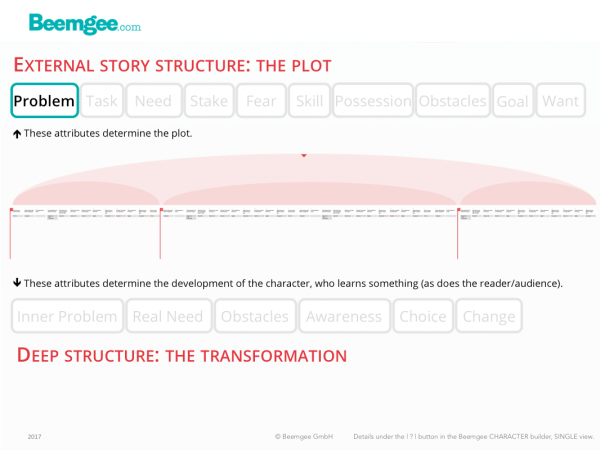
The external problem of the main character triggers the plot. It is shown to the audience as the incident which eventually incites the protagonist to action.
In some genres this is easy to see. In crime or mystery fiction, the external problem is almost by definition the crime or mystery that the protagonist has to deal with.(more…)
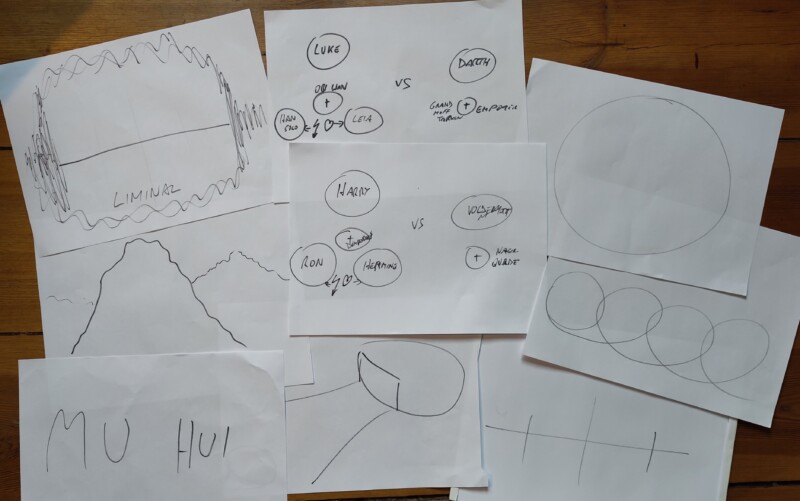



















 Nicole Boske heads the editorial team at
Nicole Boske heads the editorial team at 








